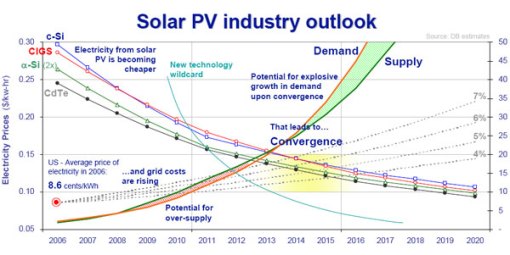 The generation of electricity from solar energy could not have been possible without the discovery of the photoelectric effect in 1839 by Becquerel (described by Einstein in his 1905 paper for which he later received the Nobel price). In 1954 the first silicon based solar cell was invented at Bell Labs and subsequently applied in the Vanguard I space satellite in 1958 where solar cells generated 1Watt of electrical power to drive the radios of the satellite. Since the Bell solar cell, that achieved 4% efficiency, the photovoltaic (PV) research focus has been on improving the efficiency of the conversion as well as lowering the costs of the device. Recently Stephen O’Rourke, a research analyst from Deutsche Bank,[1] as well as others[2]have put statements forward such as in what year electricity generated by solar panels would achieve “grid parity”. Grid parity is reached when the cost price of PV generated electricity starts to compete with the local retail price of the centrally generated grid electricity. Of course this would be without any (government) incentives. Important economic parameters solar systems are:
The generation of electricity from solar energy could not have been possible without the discovery of the photoelectric effect in 1839 by Becquerel (described by Einstein in his 1905 paper for which he later received the Nobel price). In 1954 the first silicon based solar cell was invented at Bell Labs and subsequently applied in the Vanguard I space satellite in 1958 where solar cells generated 1Watt of electrical power to drive the radios of the satellite. Since the Bell solar cell, that achieved 4% efficiency, the photovoltaic (PV) research focus has been on improving the efficiency of the conversion as well as lowering the costs of the device. Recently Stephen O’Rourke, a research analyst from Deutsche Bank,[1] as well as others[2]have put statements forward such as in what year electricity generated by solar panels would achieve “grid parity”. Grid parity is reached when the cost price of PV generated electricity starts to compete with the local retail price of the centrally generated grid electricity. Of course this would be without any (government) incentives. Important economic parameters solar systems are:
- – cost per Watt at module level (depends very strongly on the technology used and on the efficiency)
- – cost per Watt at system level (depends on the cost at module level and the costs of the downstream equipment, can be as high as $7/Watt for a residential system)
- – cost per kWh produced (depends on the two line items above and in addition on the lifetime of the entire system, i.e. how many kWh will be cumulatively be produced)
Module refers to the actual solar panel and system refers to the solar panel plus all the downstream equipment needed, such as a DC-AC inverter. On average the retail price of grid electricity in the USA is about 0.09 $/kWh, whereas the PV electricity cost price ran in 2006 at about 0.3 $/kWh. The question is now of course how the price of grid and PV electricity will change in the coming years. Grid electricity is expected to rise to about 0.20 $/kWh by 2020. O’Rourke and his team[3] developed models to predict how the price of PV electricity would come down in that same period. In the figure below the results of that analysis are made clear.
(Figure reprinted with permission of Stephen O’Rourke, Deutsche Bank)
We see that over the period of 2006 till 2020 the grid electricity price will continue to increase, the price of fossil fuels will be an important driver for that trend. In that same period we see the price of PV electricity coming down. Important contributors to that trend are cheaper PV technologies, a better economy of scale and improved manufacturing methods. Depending on which scenario is followed we see that at around 2015 grid parity is reached. However, O’Rourke noted that even at grid parity (depends also strongly on in which part of the world you are because of the amount of sunlight received), PV electricity would merely be used as a peak power supplement and not so much as a base load supplement, but nevertheless it starts to looks attractive.
At this moment the global PV contribution to the total primary energy supply (TPES) is of the order of 0.1%, but is rapidly growing. The life cycle greenhouse gas emissions of PV electricity is 20 to 30 times less than fossil fuel fired power plants. Therefore, if PV electricity continues to increase at it current pace it will substantially contribute to a sustainable society in the years to come.
Two more important aspects need to be taken into account: will PV over its life cycle a) result in a net energy return versus energy invested and b) result in lower greenhouse gas emissions? The answers for both are positive, more about that in a future blog.
Read also the blog on the price breakdown of PV systems: https://secondlawoflife.wordpress.com/2008/05/01/bright-future-for-solar-electricity/
Copyright © 2008 John Schmitz
[1] Stephen O’Rourke, at the SEMI Industry Strategy Symposium, Jan 2008, California: www.semiconductor.net/article/CA6526670.html?nid=3664
[2]Paul Basore, Renewable Energy Group: There’s lots of silicon in photovoltaic cells, but is there any gold for the electronics industry? – Practical Chip Design – Blog on EDN – 1690000169
[3]Steve O’Rourke, Peter Kim, Hari Polavarapu, Solar Photovoltaics, July 2007, Deutsche Bank
